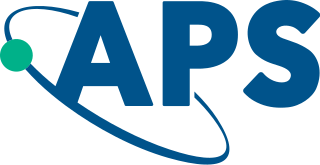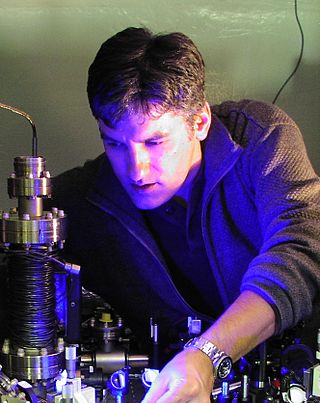Related Research Articles

Quantum gravity (QG) is a field of theoretical physics that seeks to describe gravity according to the principles of quantum mechanics. It deals with environments in which neither gravitational nor quantum effects can be ignored, such as in the vicinity of black holes or similar compact astrophysical objects, such as neutron stars as well as in the early stages of the universe moments after the Big Bang.

The American Physical Society (APS) is a not-for-profit membership organization of professionals in physics and related disciplines, comprising nearly fifty divisions, sections, and other units. Its mission is the advancement and diffusion of knowledge of physics. The society publishes more than a dozen scientific journals, including the prestigious Physical Review and Physical Review Letters, and organizes more than twenty science meetings each year. APS is a member society of the American Institute of Physics. Since January 2021 the organization has been led by chief executive officer Jonathan Bagger.

Carl Edwin Wieman is an American physicist and educationist at Stanford University, and currently the A.D White Professor at Large at Cornell University. In 1995, while at the University of Colorado Boulder, he and Eric Allin Cornell produced the first true Bose–Einstein condensate (BEC) and, in 2001, they and Wolfgang Ketterle were awarded the Nobel Prize in Physics. Wieman currently holds a joint appointment as Professor of Physics and Professor in the Stanford Graduate School of Education, as well as the DRC Professor in the Stanford University School of Engineering. In 2020, Wieman was awarded the Yidan Prize in Education Research for "his contribution in developing new techniques and tools in STEM education." citation.
William "Bill" Kent Wootters is an American theoretical physicist, and one of the founders of the field of quantum information theory. In a 1982 joint paper with Wojciech H. Zurek, Wootters proved the no cloning theorem, at the same time as Dennis Dieks, and independently of James L. Park who had formulated the no-cloning theorem in 1970. He is known for his contributions to the theory of quantum entanglement including quantitative measures of it, entanglement-assisted communication and entanglement distillation. The term qubit, denoting the basic unit of quantum information, originated in a conversation between Wootters and Benjamin Schumacher in 1992.
In physics, interaction-free measurement is a type of measurement in quantum mechanics that detects the position, presence, or state of an object without an interaction occurring between it and the measuring device. Examples include the Renninger negative-result experiment, the Elitzur–Vaidman bomb-testing problem, and certain double-cavity optical systems, such as Hardy's paradox.

Robert M. Wald is an American theoretical physicist and professor at the University of Chicago. He studies general relativity, black holes, and quantum gravity and has written textbooks on these subjects.
Quantum dimer models were introduced to model the physics of resonating valence bond (RVB) states in lattice spin systems. The only degrees of freedom retained from the motivating spin systems are the valence bonds, represented as dimers which live on the lattice bonds. In typical dimer models, the dimers do not overlap.
Daniel Amihud Lidar is the holder of the Viterbi Professorship of Engineering at the University of Southern California, where he is a professor of electrical engineering, chemistry, physics and astronomy. He is the director and co-founder of the USC Center for Quantum Information Science & Technology (CQIST) as well as scientific director of the USC-Lockheed Martin Quantum Computing Center, notable for his research on control of quantum systems and quantum information processing.

Xiao-Gang Wen is a Chinese-American physicist. He is a Cecil and Ida Green Professor of Physics at the Massachusetts Institute of Technology and Distinguished Visiting Research Chair at the Perimeter Institute for Theoretical Physics. His expertise is in condensed matter theory in strongly correlated electronic systems. In Oct. 2016, he was awarded the Oliver E. Buckley Condensed Matter Prize.
Peter Hänggi is a theoretical physicist from Switzerland, Professor of Theoretical Physics at the University of Augsburg. He is best known for his original works on Brownian motion and the Brownian motor concept, stochastic resonance and dissipative systems. Other topics include, driven quantum tunneling, such as the discovery of coherent destruction of tunneling (CDT), phononics, relativistic statistical mechanics and the foundations of classical and quantum thermodynamics.
Berthold-Georg Englert is Provost's Chair Professor at the National University of Singapore, and Principal Investigator at the Centre for Quantum Technologies. In 2006, he was recognized for outstanding contributions to theoretical research on quantum coherence. Englert's principal research interests concern applications in quantum information science, but he is also known for his early work on quantum optics together with Marlan Scully at Texas A&M University.
In quantum many-body physics, topological degeneracy is a phenomenon in which the ground state of a gapped many-body Hamiltonian becomes degenerate in the limit of large system size such that the degeneracy cannot be lifted by any local perturbations.

Christopher Roy Monroe is an American physicist and engineer in the areas of atomic, molecular, and optical physics and quantum information science, especially quantum computing. He directs one of the leading research and development efforts in ion trap quantum computing. Monroe is the Gilhuly Family Presidential Distinguished Professor of Electrical and Computer Engineering and Physics at Duke University and is College Park Professor of Physics at the University of Maryland and Fellow of the Joint Quantum Institute and Joint Center for Quantum Computer Science. He is also co-founder of IonQ, Inc.

Yasunori Nomura is a theoretical physicist working on particle physics, quantum gravity, and cosmology. He is a professor of physics at University of California, Berkeley, a senior faculty scientist at Lawrence Berkeley National Laboratory, a senior research scientist at Riken, and an affiliate member at Kavli Institute for the Physics and Mathematics of the Universe. Since 2015, he has been the director of the Berkeley Center for Theoretical Physics.
Nikolay Victorovich Prokof'ev is a Russian-American physicist known for his works on supersolidity and strongly correlated systems and pioneering numerical approaches.
Henriette D. Elvang is a Theoretical Particle Physicist and Professor at the University of Michigan. She works on quantum field theory and scattering processes.
Nandini Trivedi is an Indian-American physicist and Professor of Physics at Ohio State University. Her research is on the emergence of new states of matter arising from strong interactions between electrons in quantum materials. She was elected a Fellow of the American Association for the Advancement of Science in 2020.
David Alan Huse is an American theoretical physicist, specializing in statistical physics and condensed matter physics.
Quantum mechanics is a difficult subject to teach due to its counterintuitive nature. As the subject is now offered by advanced secondary schools, educators have applied scientific methodology to the process of teaching quantum mechanics, in order to identify common misconceptions and ways of improving students' understanding.

Germán Sierra is a Spanish theoretical physicist, author, and academic. He is Professor of Research at the Institute of Theoretical Physics Autonomous University of Madrid-Spanish National Research Council.
References
- ↑ "About PhysPort", PhysPort, American Association of Physics Teachers, retrieved 2024-03-16
- ↑ "About the Living Physics Portal", Living Physics Portal, American Association of Physics Teachers, retrieved 2024-03-16
- ↑ "EP3 Team: Sarah "Sam" McKagan", Effective Practices for Physics Programs, American Physical Society, retrieved 2024-03-16
- 1 2 3 Curriculum vitae (PDF), retrieved 2024-03-16
- ↑ "Notices", UW News, University of Washington, May 20, 2004, retrieved 2024-03-16
- ↑ Sarah “Sam” McKagan Named as Recipient of the 2013 Homer L. Dodge Citation for Distinguished Service to AAPT, American Association of Physics Teachers, September 26, 2012, retrieved 2024-03-16
- ↑ "Fellows nominated in 2018 by the Topical Group on Physics Education Research", APS Fellows archive, American Physical Society, retrieved 2024-03-16